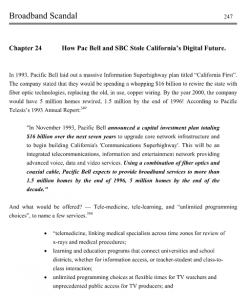About “The Book of Broken Promises: $400 Billion Broadband Scandal & Free the Net”, by Bruce Kushnick
https://www.reddit.com/r/explainlikeimfive/comments/6c5e97/eli5_how_were_isps_able_to_pocket_the_200_billion/
explainlikeimfive:
I’ve seen this thread in multiple places across Reddit:
I’m usually skeptical of such dramatic claims, but I’ve only found one contradictory source online, and it’s a little dramatic itself:
So my question is: how were ISP’s able to receive so much money with zero accountability? Did the government really set up a handshake agreement over $200 billion?
Bruce Kushnick’s Response:
Maybe you should go to the source: I’ve written three books about this starting in 1998 — and all of these appear to be related to the same threads — over two decades.
Here’s a free copy of the latest book, “The Book of Broken Promises: $400 Billion Broadband Scandal & Free the Net”, which we put up a few
weeks ago because few, if anyone actually bothered to read how the calculations were done. They were based on the Telecom companies’ annual reports, state filings, etc.– and the data is based on 20 years of documentation.
I’ve been tracking the Telecom deployments of fiber optics since 1991 when they were announced as something called the Information Superhighway. The plan was to have America be the first fiber optic country — and each phone company went to their state commissions and legislatures and got tax breaks and rate increases to fund these ‘Utility network’ upgrades that were supposed to replace the existing copper wires with fiber optics — starting in 1992. It was all a con.
As a former senior telecom analyst (the Telecoms my clients) I realized that they had submitted fraudulent cost models, and fabricated the deployment plans. The first book, 1998, laid out some of the history “The Unauthorized Biography of the Baby Bells” with foreword by Dr. Bob Metcalfe (co-inventor of Ethernet networking). I then released “$200 Billion Broadband Scandal” in 2005, which gave the details as by then more than 1/2 of America should have been completed — but wasn’t. The mergers to make the Telecom companies larger were also supposed to bring broadband– but it didn’t. I updated the book in 2015 “The Book of Broken Promises $400 Billion broadband Scandal and Free the Net”, but realized that there were other scams along side this — like manipulating the accounting.
We paid about 9 times for upgrades to fiber for home or schools and we got nothing to show for it — about $4000-7000 per household (though it varies by state and telco). By 2017 it’s over 1/2 trillion.
Finally, I note. These are not “ISPs”; they are State Telecommunications Utility companies that were able to take over the other businesses (like ISPs) thanks to the FCC under Mike Powell, now the head of the cable association.
They got away with it because they could create a fake history that reporters and politicians kept repeating. No state has ever done a full audit of the monies collected in the name of broadband; no state ever went back and reduced rates or held the companies accountable. And no company ever ‘outed’ the other companies– i.e., Verizon NJ never said that AT&T California didn’t do the upgrades.
That’s because they are all guilty of the same scheme, more or less. I do note that Verizon at least rolled out some fiber. AT&T pulled a bait and switch and deployed U-Verse over the aging copper wires (with a ‘fiber node’ within a mile).
It’s time to take this to court. Period. We should go after the financial manipulations (cross-subsidies) where instead of doing the upgrades to fiber, they took the money and spent it everywhere else, like buying AOL or Time Warner (or overseas investments), etc. We should hold them accountable before this new FCC erases all of the laws and obligations.

